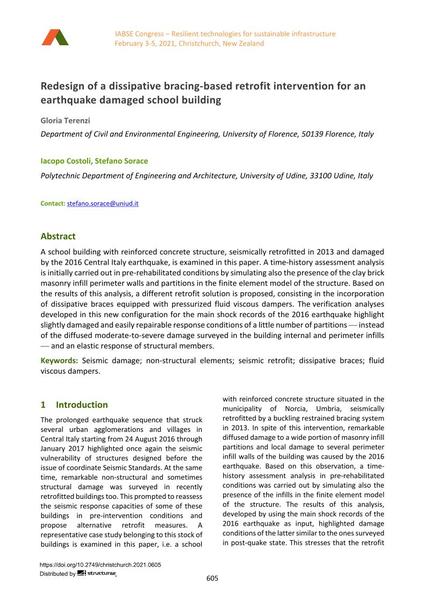Redesign of a dissipative bracing-based retrofit intervention for an earthquake damaged school building

|
|
|||||||||||
Bibliografische Angaben
| Autor(en): |
Gloria Terenzi
(Department of Civil and Environmental Engineering, University of Florence, 50139 Florence, Italy)
Iacopo Costoli (Polytechnic Department of Engineering and Architecture, University of Udine, 33100 Udine, Italy) Stefano Sorace (Polytechnic Department of Engineering and Architecture, University of Udine, 33100 Udine, Italy) |
||||
|---|---|---|---|---|---|
| Medium: | Tagungsbeitrag | ||||
| Sprache(n): | Englisch | ||||
| Tagung: | IABSE Congress: Resilient technologies for sustainable infrastructure, Christchurch, New Zealand, 3-5 February 2021 | ||||
| Veröffentlicht in: | IABSE Congress Christchurch 2020 | ||||
|
|||||
| Seite(n): | 605-613 | ||||
| Anzahl der Seiten (im PDF): | 9 | ||||
| DOI: | 10.2749/christchurch.2021.0605 | ||||
| Abstrakt: |
A school building with reinforced concrete structure, seismically retrofitted in 2013 and damaged by the 2016 Central Italy earthquake, is examined in this paper. A time-history assessment analysis is initially carried out in pre-rehabilitated conditions by simulating also the presence of the clay brick masonry infill perimeter walls and partitions in the finite element model of the structure. Based on the results of this analysis, a different retrofit solution is proposed, consisting in the incorporation of dissipative braces equipped with pressurized fluid viscous dampers. The verification analyses developed in this new configuration for the main shock records of the 2016 earthquake highlight slightly damaged and easily repairable response conditions of a little number of partitions — instead of the diffused moderate-to-severe damage surveyed in the building internal and perimeter infills — and an elastic response of structural members. |
||||
| Stichwörter: |
Erdbebennachbemessung
|
||||
